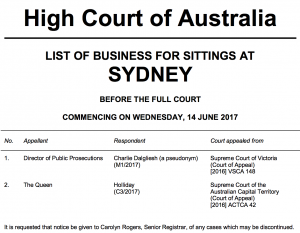Two weeks ago, I ‘live tweeted’ a hearing at Victoria’s Court of Appeal, sending out roughly 115 tweets in around an hour (‘storified’ here) of discussions about alleged contempt by three Ministers. It was my first try at live tweeting and the tweets were well received and distributed – and, it turns out, wrong. At last Friday’s hearing, a court officer told me that the use of mobile phones (or even having them on) is forbidden in Victoria’s Supreme Court When I asked if that included live tweeting, he told me that if I ‘argued any more’, I’d have to leave. It turns out, though, that there is a rule on live tweeting by ‘members of the public’ set out on the Court’s website:
Accredited journalists may use electronic equipment for the publication of material on the internet (blogging, twittering and similar)…. Non-accredited journalists, free-lance writers, ‘citizen journalists’ and members of the public need to seek permission from the trial judge for the use of electronic equipment in Court.
Alas, this rule is cleverly hidden away. While court visitors who consult the website’s instructions on ‘court etiquette‘ are simply told to ‘turn off all mobile phones and other electronic equipment’, those seeking the process allowing them to live tweet must first click ‘contact us’, then ‘media centre’, then a link that directs ‘members of the media’ to a document titled ‘media policies and practices‘, which has a heading – ‘journalists using electronic equipment in court’ – where the above discussion is buried in the middle (behind a sign that says ‘beware of the leopard’.) How visitors are meant to seek permission to live tweet appeal proceedings, particularly urgently scheduled ‘mentions’ such as those about contempt, is anyone’s guess.
So, what is the policy on live tweeting High Court proceedings? Continue reading
